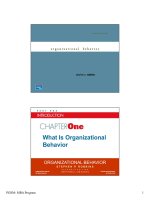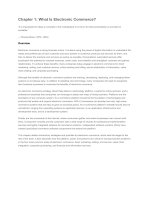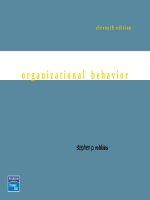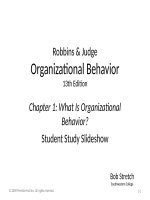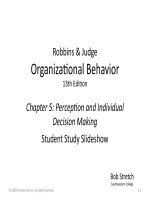Slide OB 13e chapter 01 what is organizational behavior
Bạn đang xem bản rút gọn của tài liệu. Xem và tải ngay bản đầy đủ của tài liệu tại đây (152.87 KB, 28 trang )
Robbins & Judge
Organizational Behavior
13th Edition
Chapter 1: What Is Organizational
Behavior?
Student Study Slideshow
Bob Stretch
Southwestern College
© 2009 Prentice-Hall Inc. All rights reserved.
1-1
Chapter Learning Objectives
• After studying this chapter you should be able to:
– Demonstrate the importance of interpersonal skills in the
workplace.
– Describe the manager’s functions, roles, and skills.
– Define organizational behavior (OB).
– Show the value to OB of systematic study.
– Identify the major behavioral science disciplines that
contribute to OB.
– Demonstrate why there are few absolutes in OB.
– Identify the challenges and opportunities managers have in
applying OB concepts.
– Compare the three levels of analysis in this book’s OB
model.
© 2009 Prentice-Hall Inc. All rights reserved.
1-2
The Importance of Interpersonal Skills
• Understanding OB helps determine manager
effectiveness
– Technical and quantitative skills important
– But leadership and communication skills are CRITICAL
• Organizational benefits of skilled managers
– Lower turnover of quality employees
– Higher quality applications for recruitment
– Better financial performance
© 2009 Prentice-Hall Inc. All rights reserved.
1-3
What Managers Do
• They get things done through other people.
• Management Activities:
– Make decisions
– Allocate resources
– Direct activities of others to attain goals
• Work in an organization
– A consciously coordinated social unit composed of
two or more people that functions on a relatively
continuous basis to achieve a common goal or set of
goals.
© 2009 Prentice-Hall Inc. All rights reserved.
1-4
Four Management Functions
• PLAN
– A process that includes defining goals, establishing strategy, and
developing plans to coordinate activities.
• ORGANIZE
– Determining what tasks are to be done, who is to do them, how the
tasks are to be grouped, who reports to whom, and where decisions
are to be made.
© 2009 Prentice-Hall Inc. All rights reserved.
1-5
Four Management Functions
• LEAD
– A function that includes motivating employees, directing others,
selecting the most effective communication channels, and resolving
conflicts.
• CONTROL
– Monitoring performance, comparing actual performance with
previously set goals, and correcting any deviation.
© 2009 Prentice-Hall Inc. All rights reserved.
1-6
Mintzberg’s Managerial Roles
• Ten roles in three groups (Exhibit 1-1)
• Interpersonal
– Figurehead, Leader, and Liaison
• Informational
– Monitor, Disseminator, Spokesperson
• Decisional
– Entrepreneur, Disturbance Handler, Resource Allocator, and Negotiator.
© 2009 Prentice-Hall Inc. All rights reserved.
1-7
Katz’s Essential Management Skills
• Technical Skills
– The ability to apply specialized knowledge or expertise
• Human Skills
– The ability to work with, understand, and motivate
other people, both individually and in groups
• Conceptual Skills
– The mental ability to analyze and diagnose complex
situations
© 2009 Prentice-Hall Inc. All rights reserved.
1-8
Luthans’ Study of Managerial Activities
• Four types of managerial activity:
– Traditional Management
• Decision-making, planning, and controlling.
– Communication
• Exchanging routine information and processing paperwork
– Human Resource Management
• Motivating, disciplining, managing conflict, staffing and training.
– Networking
• Socializing, politicking, and interacting with others.
• Managers who promoted faster (were successful) did
different things than did effective managers (those who
did their jobs well) – see Exhibit 1-2.
© 2009 Prentice-Hall Inc. All rights reserved.
1-9
Organizational Behavior
A field of study that investigates the impact that
individuals, groups, and structure have on behavior
within organizations, for the purpose of applying such
knowledge toward improving an organization’s
effectiveness.
© 2009 Prentice-Hall Inc. All rights reserved.
1-10
Intuition and Systematic Study
• Intuition
– Gut feelings
– Individual observation
– Common sense
• Systematic Study
– Looks at relationships
– Scientific evidence
– Predicts behaviors
• The two are complementary means of predicting
behavior.
© 2009 Prentice-Hall Inc. All rights reserved.
1-11
An Outgrowth of Systematic Study…
Evidence-Based Management (EBM)
– Basing managerial decisions on the best available scientific
evidence.
– Must think like scientists:
• Pose a managerial question
• Search for best available evidence
• Apply relevant information to case
© 2009 Prentice-Hall Inc. All rights reserved.
1-12
Managers Should Use All Three
Approaches
The trick is to know when to go with your gut.
– Jack Welsh
• Intuition is often based on inaccurate information
• Faddism is prevalent in management
• Systematic study can be time-consuming
Use evidence as much as possible to inform your
intuition and experience. That is the promise of OB.
© 2009 Prentice-Hall Inc. All rights reserved.
1-13
Four Contributing Disciplines
• Psychology
The science that seeks to measure, explain, and
sometimes change the behavior of humans and
other animals.
– Unit of Analysis:
• Individual
– Contributions to OB:
• Learning, motivation, personality, emotions, perception
• Training, leadership effectiveness, job satisfaction
• Individual decision making, performance appraisal, attitude
measurement
• Employee selection, work design, and work stress
© 2009 Prentice-Hall Inc. All rights reserved.
1-14
Four Contributing Disciplines
• Social Psychology
An area within psychology that blends concepts
from psychology and sociology and that focuses
on the influence of people on one another.
– Unit of Analysis:
• Group
– Contributions to OB:
•
•
•
•
•
Behavioral change
Attitude change
Communication
Group processes
Group decision making
© 2009 Prentice-Hall Inc. All rights reserved.
1-15
Four Contributing Disciplines
• Sociology
The study of people in relation to their fellow
human beings.
– Unit of Analysis:
– Organizational System
–Group
– Contributions to OB:
–
–
–
–
–
–
Group dynamics
Work teams
Communication
Power
Conflict
Intergroup behavior
© 2009 Prentice-Hall Inc. All rights reserved.
–
–
–
–
Formal organization theory
Organizational technology
Organizational change
Organizational culture
1-16
Four Contributing Disciplines
• Anthropology
The study of societies to learn about human
beings and their activities.
– Unit of Analysis:
-- Organizational System
– Contributions to OB:
– Organizational culture
– Organizational environment
© 2009 Prentice-Hall Inc. All rights reserved.
-- Group
– Comparative values
– Comparative attitudes
– Cross-cultural analysis
1-17
Few Absolutes in OB
Situational factors that make the main relationship
between two variables change—e.g., the relationship
may hold for one condition but not another.
Contingency Variable (Z)
Independent Variable (X)
Dependent Variable (Y)
In American Culture
Boss Gives “Thumbs Up”
Sign
Understood as
Complimenting
In Iranian or Australian
Cultures
Boss Gives “Thumbs Up”
Sign
Understood as Insulting “Up Yours”
© 2009 Prentice-Hall Inc. All rights reserved.
1-18
Challenges and Opportunities for OB
•
•
•
•
•
•
•
•
•
•
•
Responding to Globalization
Managing Workforce Diversity
Improving Quality and Productivity
Improving Customer Service
Improving People Skills
Stimulating Innovation and Change
Coping with “Temporariness”
Working in Networked Organizations
Helping Employees Balance Work-Life Conflicts
Creating a Positive Work Environment
Improving Ethical Behavior
© 2009 Prentice-Hall Inc. All rights reserved.
1-19
Challenges and Opportunities for OB
• Responding to Globalization
–
–
–
–
–
Increased foreign assignments
Working with people from different cultures
Coping with anti-capitalism backlash
Overseeing movement of jobs to countries with low-cost labor
Managing people during the war on terror
• Managing Workforce Diversity
– The people in organizations are becoming more heterogeneous
demographically (disability, gender, age, national origin, non-Christian,
race, and domestic partners) Exhibit 1-4
– Embracing diversity
– Changing U.S. demographics
– Management philosophy changes
– Recognizing and responding to differences
© 2009 Prentice-Hall Inc. All rights reserved.
1-20
Developing an OB Model
• A model is an abstraction of reality: a simplified
representation of some real-world phenomenon.
• Our OB model has three levels of analysis:
– Each level is constructed on the prior level
• Individual
• Group
• Organizational Systems
© 2009 Prentice-Hall Inc. All rights reserved.
(Exhibit 1-5)
1-21
Types of Study Variables
Independent (X)
Dependent (Y)
– The presumed cause of the
change in the dependent
variable (Y).
– This is the variable that OB
researchers manipulate to
observe the changes in Y.
– This is the response to X (the
independent variable).
– It is what the OB researchers
want to predict or explain.
– The interesting variable!
X → Y → Predictive Ability
© 2009 Prentice-Hall Inc. All rights reserved.
1-22
Interesting OB Dependent Variables
• Productivity
– Transforming inputs to outputs at lowest cost. Includes the
concepts of effectiveness (achievement of goals) and efficiency
(meeting goals at a low cost).
• Absenteeism
– Failure to report to work – a huge cost to employers.
• Turnover
– Voluntary and involuntary permanent withdrawal from an
organization.
• Deviant Workplace Behavior
– Voluntary behavior that violates significant organizational norms
and thereby threatens the well-being of the organization and/or
any of its members.
© 2009 Prentice-Hall Inc. All rights reserved.
1-23
More Interesting OB Dependent
Variables
• Organizational Citizenship Behavior (OCB)
– Discretionary behavior that is not part of an employee’s formal job
requirements, but that nevertheless promotes the effective
functioning of the organization.
• Job Satisfaction
– A general attitude (not a behavior) toward one’s job; a positive feeling
about one's job resulting from an evaluation of its characteristics.
© 2009 Prentice-Hall Inc. All rights reserved.
1-24
The Independent Variables
The independent variable (X) can be at any of these three
levels in this model:
•Individual
– Biographical characteristics, personality and emotions, values
and attitudes, ability, perception, motivation, individual learning
and individual decision making.
•Group
– Communication, group decision making, leadership and trust,
group structure, conflict, power and politics, and work teams.
•Organization System
– Organizational culture, human resource policies and practices,
and organizational structure and design.
© 2009 Prentice-Hall Inc. All rights reserved.
1-25
